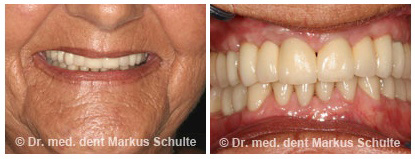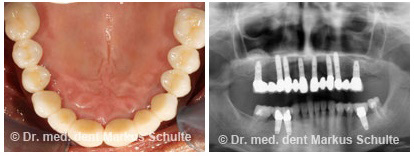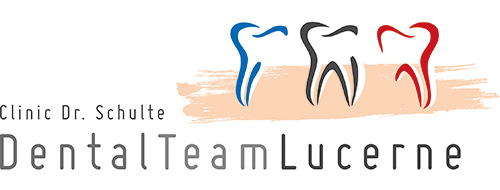Fixed Teeth In One Day
Fixed Teeth In One Day
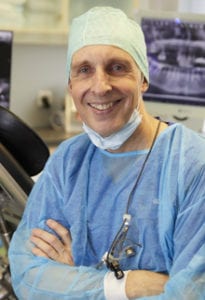
When all teeth are missing or have to be removed and there is no desire to make do with removable dentures, the path to permanent teeth used to be quite long and painful:
In most cases, several operations were necessary in order first to extract the teeth, then to augment the bone (e.g. the sinus lift procedure) and finally, approx. 6 months later, to fit the implants which then needed to heal without loading. In the intermediate period of up to a year, patients had to contend with ill-fitting removable full dentures as a temporary measure and a considerable loss in quality of life.
In addition, the significant time and effort involved (bone augmentation plus 6-8 implants per jaw) led to extremely high costs, unaffordable for many patients. Luckily, innovative surgical procedures are available now that make the path to permanent teeth significantly shorter and more affordable:
For more than 15 years, we have been using in our clinic the All-On-Four technique, which I would like to introduce to you on these pages. With this safe and low-complication method we have since helped over 600 patients to fixed, beautiful teeth within one day.This makes us the clinic of Switzerland that has the greatest experience with this method. Therefore, we have been recognized by Nobel Biocare as “All-On-Four Competence Center Switzerland”. In order to offer you a factual overview of the possibilities and methods of the technique “Fixed teeth in one day”, you will find here extensive information and case studies which you can either read in sections or save or print out as a PDF file.
Read or print a complete article on one page: Wisdom Teeth
Fixed Teeth In One Day
The All-On-Four® technique: Four stable supports for a dazzling smile
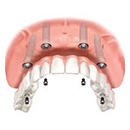
The fastest path to fixed teeth: The All-On-Four method requires no bone augmentation. Only a few hours after the operation, the provisional bridge is firmly screwed onto the four implants.
The All-On-Four method makes it possible to fit a fixed dental bridge for immediate restoration with only four implants per jaw. As a rule, this requires only one surgical procedure which can also be performed under general or twilight anaesthesia. Any teeth still in place can be removed at the same time. The posterior implants are fitted tilted at an angle of 30-45 degrees. Normally, there is no need for a bone augmentation and the technique permits the fitting of longer and particularly stable implants that can stand up to immediate loading with fixed dentures.
A few hours after the fitting of the 4 implants, a provisional bridge – produced in advance in our dental laboratory – is firmly screwed to the implants. The patient leaves our dental surgery with fixed teeth for immediate loading. The definite prosthesis is produced about three months later.
How does it work? A brief explanation of the All-On-Four principle
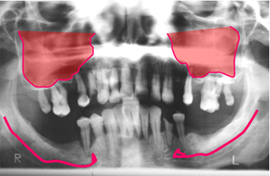
The problem: bone loss
The X-ray of a patient prior to treatment shows the problem areas in implant treatment: highlighted in red are the maxillary sinus in the upper jaw and the sensory nerve to the lower lip in the lower jaw.
These anatomical structures which must not be impaired often impose serious restrictions on the available bone below the sinuses or above the nerve in the lower jaw. For that reason, it is often impossible to fit traditional implants in the posterior section of the upper and lower jaws without bone augmentation.
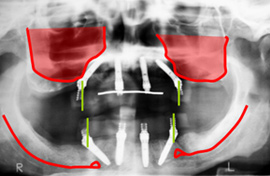
The solution: the proper angle
The All-On-Four technique avoids the anatomical “obstacles” outlined earlier by fitting the posterior implants inclined at a forward angle (30-45°). This makes optimum use of the generally better preserved bone in the anterior jaw regions and avoids contact with the sinuses and the nerve in the lower jaw. The inclination of the implants also allows the use of significantly longer and much more stable implants. In turn, this permits the immediate loading of the implants with a fixed bridge on the same day as the operation. Scientific studies have confirmed beyond doubt that in the long term, too, tilted implants function just as well as those fitted vertically.
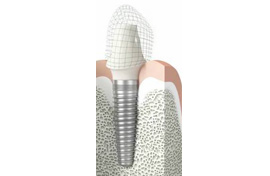
Immediate loading
Titanium implants require approximately 2-3 months to bind firmly to the bone, or even up to 6 months after bone augmentation. This extremely stable connection between bone and titanium is known as osseointegration. Immediate loading is the term used for fitting a fixed prosthesis (e.g. a dental bridge) onto the freshly placed implants without waiting for the completion of this healing phase.
Immediate loading has significant advantages if all teeth have to be removed: instead of a removable denture, within hours of the operation the patient is fitted with a securely screw-retained dental bridge, which aesthetically as well as functionally satisfies even high demands.
The All-On-Four technique with its four stable implants spread across the dental arch is particularly suitable for immediate restoration. Many scientific studies have now shown that with careful planning and an experienced dental surgeon the success rate of immediately loaded implants is just as high as that of the traditional procedure.
The advantages of the All-On-Four method
- Fixed teeth in a day
- No need for bone augmentation
- Lower risk of complications
- Only a single operation (general anaesthetic possible)
- Lower costs (in comparison with 6-8 implants per jaw with bone augmentation)
- Easier oral hygiene as only 4 implants require cleaning
- Outstanding aesthetics that can be adapted individually
- Screw-retained construction that makes prosthesis easy to repair if necessary
- Scientifically proven excellent long-term success rates
- Only a few treatment sessions necessary, thus also suitable for faraway patients
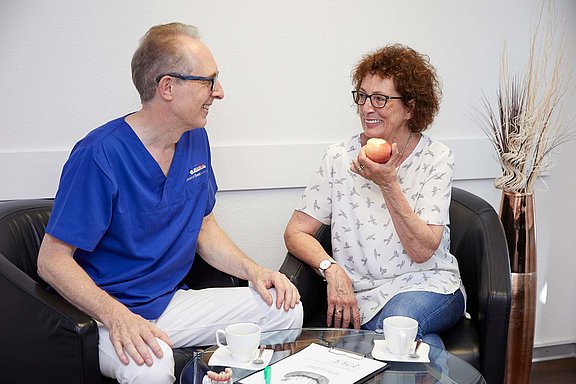
A case from our practice
Hermine Rosenthal, 61 years old from Schwellbrunn AR:
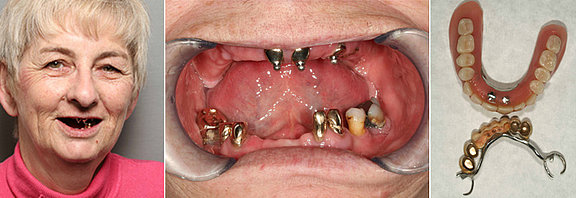
This patient had already lost many teeth in her youth. After the loss of fixed bridges, she wore removable dentures for many years. While she got on well with the prosthesis for her lower jaw and only disliked the yellowish discolouration of the teeth, the situation of her upper jaw was much more difficult. The few remaining roots (root posts with press studs) were no longer able to stabilise the prosthesis sufficiently. The badly fitting, wobbly prosthesis caused the patient to gag and was painful when eating; it had even unexpectedly fallen out a couple of times while she was speaking.
The dentist whom she consulted had advised the extraction of the remaining teeth as the first step. Then, a few months later, the bone of the upper jaw was to be augmented, and the implants fitted another six months after that. About a year after the initial operation, she would thus have received her fixed dentures. Out of fear of several painful procedures and the prospect of wearing a precarious full prosthesis, Hermine felt unable to decide on this treatment option and for a long time kept putting off the necessary dental work.
The planning
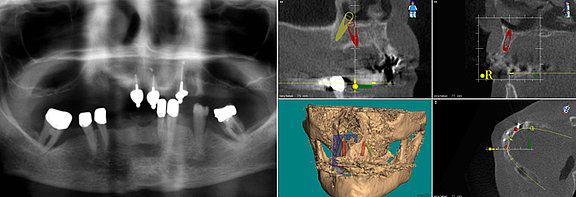
The X-ray image (left) shows – as expected – significant bone loss in the upper jaw. The computer tomography (right) which we performed allowed us to analyse the remaining bone three-dimensionally and to plan the implantation virtually. In this way, we were able to determine that the upper jaw was sufficiently dimensioned to accept four implants in accordance with the All-On-Four technique.
All that was needed for the lower jaw was to remove the posterior teeth and to adapt the existing prosthesis.
Once it had become clear that thanks to the All-On-Four method no bone augmentation would be required and the procedure could be completed in a single session under general anaesthesia, the patient agreed to the planned treatment.
A final consultation with the patient concluded the planning phase. Together with our dental technicians, the initial aesthetic situation was analysed and the patient’s wishes noted. After taking an impression and photographs, our dental laboratory was in a position to prepare the individually designed provisional prosthesis for the day of the operation.
The operation
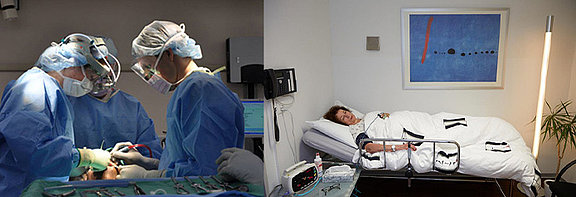
Under general anaesthesia, all teeth of the upper jaw as well as the posterior teeth of the lower jaw were extracted.
With the aid of the information gained from the computer tomography, we were then able to insert four extremely stable implants into the existing jaw bone, with the posterior posts tilted at an angle towards the front.
An impression was taken, the anaesthetic phased out, and the patient looked after in our post-anaesthesia recovery room. Thanks to the medication she has been given, she experienced almost no pain in the hours after the operation.
The fixed provisional prosthesis
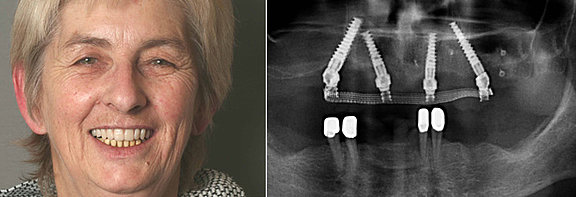
Approximately four hours after the operation, the provisional upper prosthesis produced in our dental laboratory was firmly screwed to the freshly fitted implants. Right from the very start, the patient was permitted to chew normally; only particularly hard food should be avoided for the first two months. Hermine was able to go home accompanied by another person.
Approximately one week after the operation, the stitches were removed and the bite checked once more. A dental hygienist explained to her in detail how best to clean the new teeth with a soft brush and a special dental floss.
Four months later: the definite All-On-Four bridge is fitted
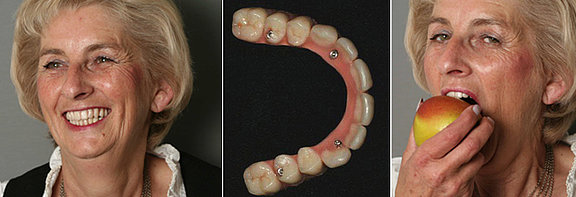
The x-ray showed the correct positioning of the four implants, which – four months after the procedure – had perfectly integrated with the jaw bone and were fully loadable.
Based on the impression taken, our dental laboratory produced the definite All-On-Four bridge which was firmly screwed to the implants. In that process, we took the patient’s wishes concerning the aesthetics into consideration.
At the same time, the old, discoloured partial prosthesis for the lower jaw was restored and its colour adapted to the teeth of the upper jaw.
In this video, Hermine Rosenthal tells her personal story about her path to new fixed teeth (in German). To watch the video, please click on the arrow in the adjoining picture.
What is the timetable for an All-On-Four treatment?
1-2 weeks prior to the operation:
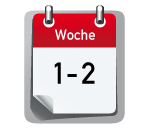
After the evaluation of the X-ray and CT images, the patient attends our surgery approx. 1 to 2 weeks prior to the operation. The planned procedure is once again discussed in detail. Photos and impressions of the current status are taken. This session is also attended by our dental technicians in order to agree the appearance of the new fixed teeth with the patient’s requests.
On the day of the operation:
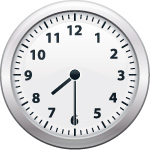
The patient comes to our surgery and can clarify any open questions with the surgeon and the anaesthetist.
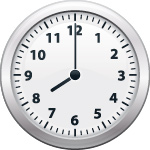
He is then accompanied to our sterile operating room. Once the general anaesthetic has been administered by the anaesthetist, the planned procedure is performed.
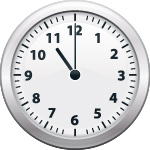
The patient wakes up after the operation and is then looked after in our post-anaesthesia recovery room. The pain medication administered under the anaesthetic ensures that the patient generally experience no or only a small amount of pain.
Only an hour later, the patient can have a drink and eat a small liquid meal
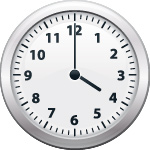
Our dental technicians have completed the provisional prosthesis in our dental laboratory; we fit it to the freshly fitted implants with screws. The patient is given the required medication (mouth rinse, pain killers and antibiotics if required) and receives detailed instructions on what to do and not to do over the following week. There is a mobile number to contact the surgeon at any time, if the need arises
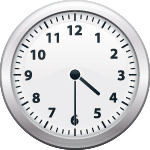
The patient leaves our surgery escorted by an accompanying person – and with fixed teeth.
Approx. 1 to 2 weeks after the operation
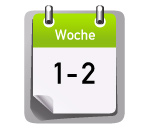
During the follow-up treatment 1 to 2 weeks after the operation, the provisional prosthesis is removed once more. The wounds are cleaned and the stitches taken out. The prosthesis is then refitted and the bite checked once more in detail.
3 to 4 months later
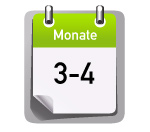
The definite fixed bridge is made in accordance with the patient’s wishes.
Competence at the centre – the focus is on the patient
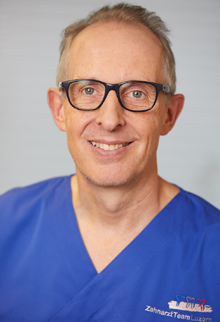
Dr. Markus Schulte is a specialist in oral surgery and has fitted thousands of implants in his more than 25 years in the profession. The All-On-Four method has been performed routinely in our dental surgery and day hospital since 2006 for total dental restorations. Many hundreds of patients have thus received fixed and beautiful teeth in a day. This makes us the All-On-Four-Center with the largest number of cases in Switzerland, recognized by Nobel Biocare as “All-On-Four Competence Center”.
For many years, Dr. Schulte has also been developing solutions to realise fixed immediate restorations of the highly atrophic upper jaw (in the case of extreme bone loss) with zygoma and pterygoid implants. In difficult cases, this surgical technique can be a good alternative to extensive bone grafts and is ideally integrated into the All-On-Four method.
Based on our many years of experience and thanks to the technical equipment of our clinic, our team can guarantee you competent advice, treatment and aftercare. Since we are convinced of the quality of our work, we grant our patients generous guarantees.

Our surgery in the heart of Lucerne offers the complete infrastructure of a modern day clinic on 400 m²:
- Sterile operating theatre for surgical procedures
- Latest generation of anaesthetic equipment and control monitors
- Supervised post-anaesthesia recovery room for the period immediately after the operation
- Integrated dental laboratory headed by a master technician for the “tailor-made“ production of prosthesis
- 6 modern treatment rooms
- Department of paediatric dentistry with a special separate waiting and treatment room appropriate for our youngest patients
Our competent team, who consistently improve their skills and knowledge in further training, also want to give you the care and support of a high-quality personal dental practice.

Narkose.ch: our trusted partner
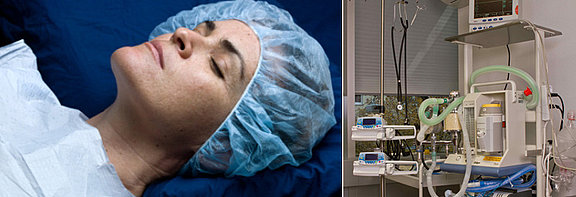
Many patients prefer not to be aware of their treatment and thus to acquire beautiful fixed teeth “in their sleep”. We can meet this request and frequently perform major surgical procedures and total restorations under general anaesthetic or deep sedation (twilight sleep). In this, we are supported by the experienced narkose.ch team with whom we have worked well for many years on the basis of mutual trust. The anaesthetists working for narkose.ch administer thousands of outpatient anaesthesias every year across all of Switzerland and thus are greatly experienced and highly competent.
Modern anaesthetic procedures make possible these days to perform very safe anaesthesia and ensure a fast recovery after the operation free from nausea and pain.
For more detailed information about treatment under general anaesthesia please click here.
Our dental laboratory: high-tech craftsmanship for beautiful teeth
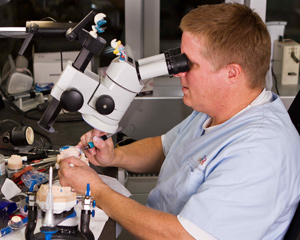
In the manufacture of prosthesis within the space of a few hours, our licensed dental laboratory, integrated into the surgery, is of crucial advantage. When needed, our dental technicians are immediately at hand and in direct contact with the patient can ensure the best fit of the prosthesis in terms of aesthetics as well as function. Craftsmanship and high-tech equipment such as a CAD-CAM scan and milling system work together hand in hand.
Safety and guarantee

Our team has many years of experience in implantology and has already helped hundreds of patients to fixed teeth in a day using the All-On-Four technique.
This experience can be crucial to avoid complications in difficult cases. It has been shown that an experienced team of dental surgeons results in fewer failures, such as loss of implants, or complications, such as sinus inflammations, damage to facial sensory nerves or severe bleeding.
According to our own statistics, the ratio of implants lost during the immediate loading and healing phase is no more than 2%. This experience is confirmed by numerous scientific studies that attest outstanding results to the All-On-Four method also in the long term.
We are firmly convinced of the longevity of the implants that we have fitted. For that reason, we give our patients a 10-year warranty against the unlikely loss of an implant.
Cost
Transparency of costs is very important for us. After the dental examination and the evaluation of the X-ray images, we produce a treatment plan and a binding quote. We offer our patients a guaranteed fixed price which remains unchanged even in case of unforeseen additional services. For example, if – contrary to expectations – the need for a fifth or sixth implant became apparent in the course of the operation, these costs would not be passed on to the patient.
As a general rule, the cost for the restoration of one jaw using the All-On-Four method is between CHF 20,000 to CHF 35,000, depending on complexity and material of the dental prosthesis. Do you want to convert the SFR prices in EURO or other currencies? Use the Online Currency Converter.
Frequently asked questions on the topic
Basically yes. There are only very few exceptions, e.g. in case of severe systemic diseases or after radiation treatment in the jaw region.
The method is suitable for patients whose teeth are all to be removed or who are already toothless (edentulous).
Based on our current knowledge, the failure rate is very low. After 10 years, more than 90% of implants fitted by experienced surgeons still function without fault. Implants can thus live for a lifetime. However, good oral hygiene is crucial for a long and problem-free “life” of the implants. Statistically, heavy smokers tend to experience more problems (inflammations and bone loss) than non-smokers.
To use the All-On-Four technique, enough bone has to be available for the stable anchorage of the four implants in the jaw. Because of the angled tilt of the posterior implants, this is very often still the case even if bone loss is marked. With the aid of computer tomography, we measure the bone accurately in all three dimensions. If the bone loss is indeed already too advanced, we have to adapt our planning accordingly. For the upper jaw, there is for example the option of using zygomatic implants that are not anchored in the upper jaw but in the cheekbone (zygomatic bone). These implants can also be anchored securely even if the jaw bone is extremely reduced. In the lower jaw, we sometimes resort to provisional implants in order to provide firm support for the prosthesis and as part of the same procedure augment the bone for the “proper” implants. In any case, our aim is always an immediate provision with fixed teeth in order to spare our patients removable dentures during the healing phase.
A major advantage of the All-On-Four method is the need for only one surgical procedure. As the result, the number of treatment sessions is significantly reduced – another advantage for patients with a full schedule and a long way to travel.
As a general rule, three to four appointments are necessary for the planning, the actual operation and the provisional prosthesis, always 1 to 2 weeks apart. Some months later, a further three appointments are needed in order to manufacture the definitive bridge.
Directly after the operation, you will normally not experience any pain thanks to the medication administered under anaesthesia. Pain that occurs later is generally well tolerable and well controlled with the pain killers we provide. During the first days, swelling may be both noticeable and visible. In most cases, all complaints have abated completely after a week and you can return to work.
These days, a general anaesthetic administered by an experience specialist in anaesthesiology is a very safe procedure. Our anaesthetists perform detailed checks on every patient in advance to ascertain whether anaesthesia can be delivered on a day-treatment basis without risk; if necessary, they will contact your GP or the specialist in charge of your treatment for more information.
If both jaws are restored at the same time, we urgently recommend a general anaesthetic. For only one jaw, treatment under a local anaesthetic is possible, optionally with additional sedation (twilight sleep).
All our patients receive personal instructions from our specially trained dental hygienists regarding the best way to clean their specific prostheses. The prosthesis is designed in such a way that the space underneath can be cleaned easily using a special dental floss. In this way, the area around the implants can be kept perfectly clean. As a general rule, oral hygiene and care is much easier for only four implants per jaw than for bridges with six or eight implants.
If a tooth of an All-On-Four bridge is chipped or broken, e.g. after biting on a grit in bread or a cherry stone, it is not a major problem. It only takes minutes to unscrew the prosthesis; it can then be repaired in our laboratory. This is a major advantage compared to bridges that are cemented in and thus no longer removable.
This is no problem at all. We have a list of patients who would be happy to talk to you about their personal experience with this treatment.
Picture Gallery
A case report from our surgery
55-year old Markus Frey from Hägglingen:

„All my life I have suffered from my catastrophic teeth. Out of fear, I had not seen a dentist for many years. I was in pain, had bad breath and was too embarrassed to be with other people. Not in my wildest dreams had I ever imagined that I would end up with new fixed teeth so quickly and painlessly. Finally, I can show my teeth and smile with confidence.“ To watch the video (in German), please click on the arrow in the adjoining picture.
Picture Gallery
This section contains pictures of actual cases from our surgery before and after total restoration with the “All-On-Four” – “fixed teeth in one day” method.








1st case study from our practice: The All-On-Four Method
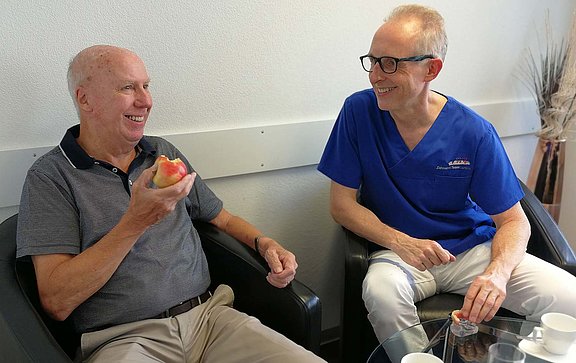
Mr. Josef Rütter from Horw
The 75-year-old Josef Rütter from Horw suffered from advanced periodontitis, various teeth were also broken off or destroyed by caries. A thorough examination showed that most of the teeth in the upper jaw could not be preserved and therefore a total renovation was necessary.
The patient remembers: “I had put my dental problems off for a long time. Partly out of fear, because of bad experiences I had earlier. But also because my dentist couldn’t offer me a convincing renovation concept. I knew that I could no longer rely on my teeth and that “plaster” treatments were no longer enough. At the same time, I wanted to maintain my quality of life with fixed teeth and not have a removable “drawer” in my mouth.
When Dr. Schulte suggested the All-On-Four method, I was immediately convinced by this concept. Only one procedure under general anesthesia – ideal for me as an anxious patient. The decisive argument for me, however, was that I would get fixed teeth the same day of the operation – without months of waiting with removable dentures. Today I know that my decision was the right one. me, beautiful, fixed teeth are a part of the quality of life I don’t want to do without.”
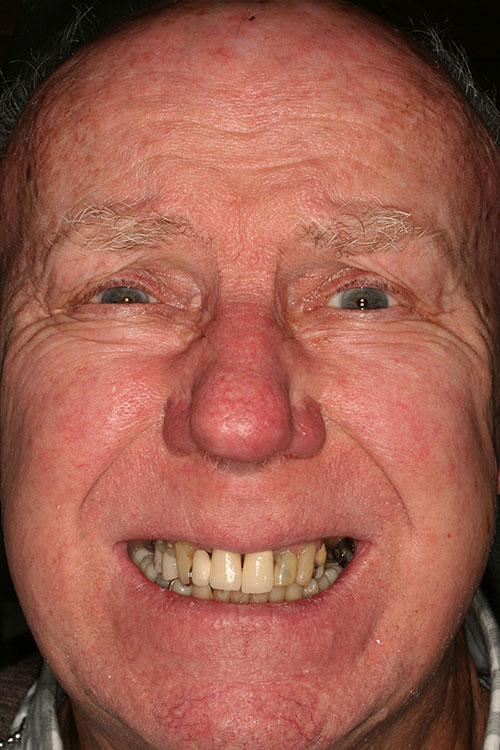
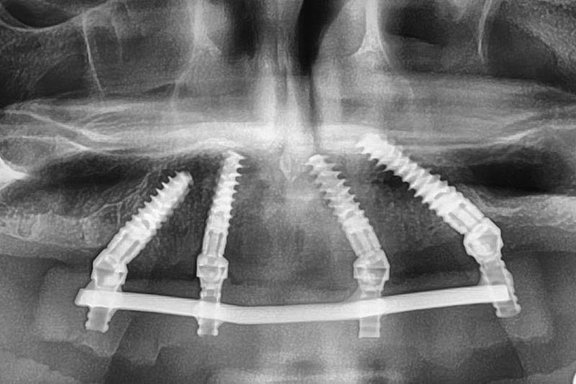
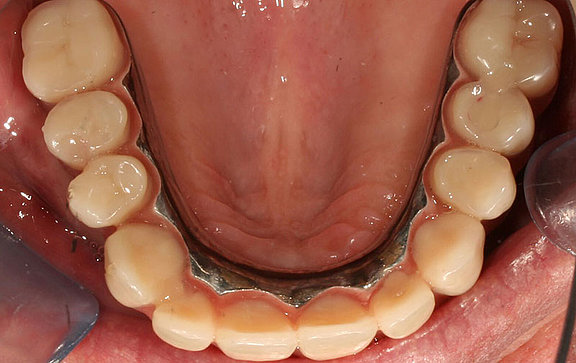
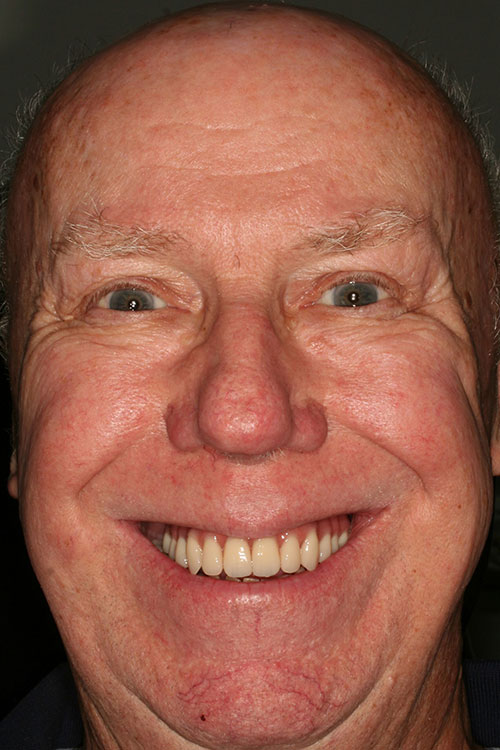
2rd case study from our practice: The All-On-Four Method
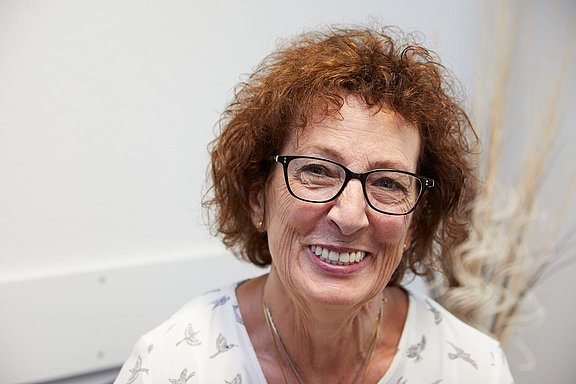
Mrs Esther Burckhardt from Thun
Our 67-year-old patient Ms. Esther Burckhardt from Thun reports: “I suffered from severe periodontitis and could hardly eat with my loose teeth. The inflammation caused me chronic pain and I had to take strong pain pills on a regular basis. For fear of painful operations and lengthy treatments, I had always put the topic of implants off before me. In the end, with my repulsing teeth, I no longer dared to be around people and felt increasingly isolated and depressed. When I heard about the All-On-Four method from my daughter, I regained hope again. Fixed teeth immediately, that was just a pipe dream up to now. Then one day I got up for a complete renovation under general anesthesia. I have never regretted my decision to solve my dental problem once and for all. With my fixed, beautiful teeth, I now have a completely different attitude towards life, I feel much younger and more self-confident. And I can eat what I want again without a care. ”
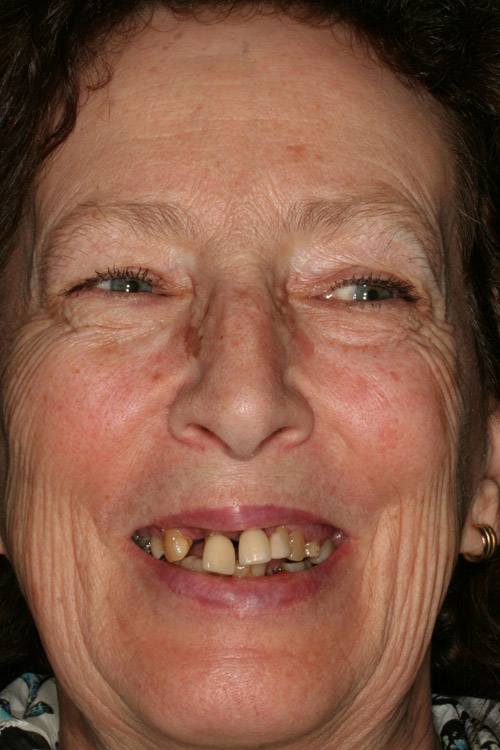
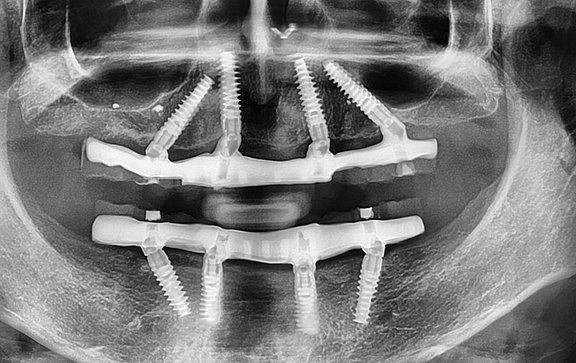
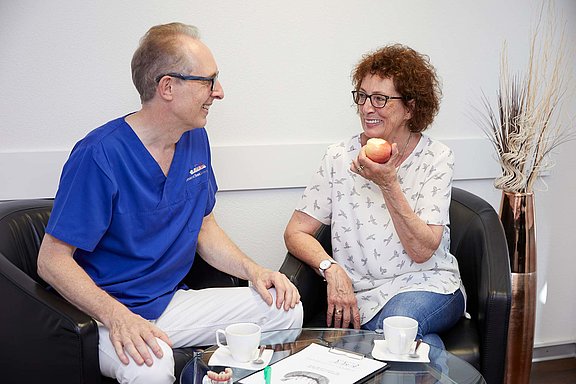
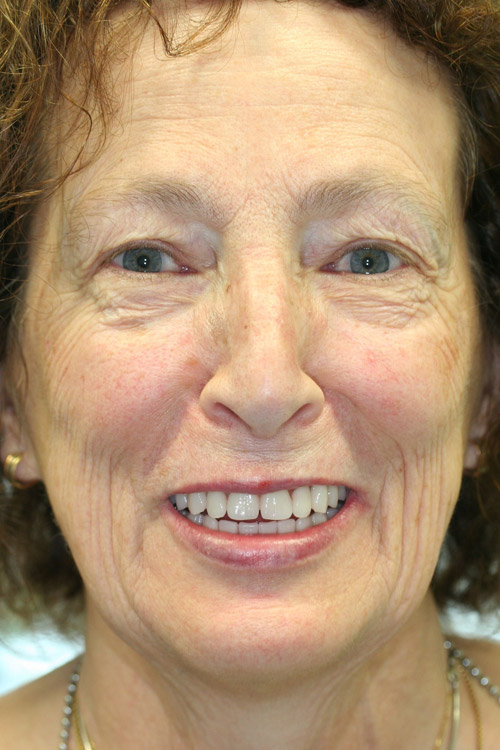
3rd case study from our practice: 8 implants in the upper jaw
Examples I and II show the All-On-4 method with a fixed bridge on four implants. In particularly demanding cases it is sometimes better not to fit the jaw with a dental replacement consisting of one piece but to use separate individual ceramic implant bridges instead. For this very elaborate procedure 8 implants usually have to be placed in the upper jaw, while in the lower jaw six implants are usually sufficient. Our aim is always immediate function (immediate loading) in the region of the front implants in order to spare the patient a tedious healing phase of several months with removable provisional bridgework.
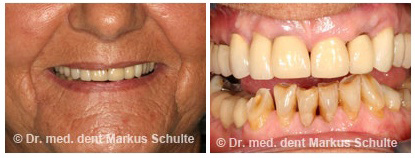
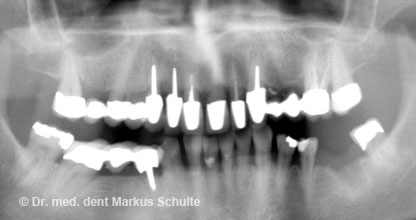
This 65-year-old woman consulted our practice because she was increasingly unhappy with the cosmetic appearance of her 20-year old bridges in the upper jaw. At the first examination we found that the dental substance under the bridges was severely damaged by tooth decay. The prognosis of the pivot teeth under the crowns was so poor that it did not seem advisable to make new bridges for the existing teeth. The patient therefore decided on full reconstruction with extraction of all upper teeth and replacement with 8 implants and 4 separate ceramic bridges. For the reconstruction of the lower jaw we planned 3 implants and restoration of all teeth with single all-ceramic crowns.
First we performed careful planning on the basis of X-rays, models and photos. A computed tomographic scan (CBVT) permitted a three-dimensional analysis of the jawbone and virtual simulation of the implantation on the computer.
The operation was performed under general anaesthesia. At the same time as removing the teeth we were able to place eight stable implants in the upper jaw; for the back right implant bone augmentation (sinus lift) was necessary. In addition we performed gum augmentation with a gum graft in order to strengthen the gum tissue around the implants and prevent gum loss. At the end of the operation a previously fabricated fixed provisional bridge was firmly screwed on to the front six implants while the two back implants were allowed to heal without loading.
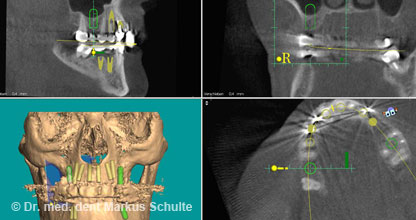
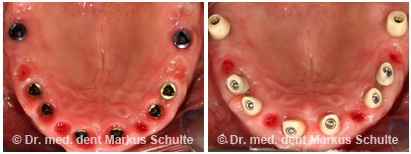
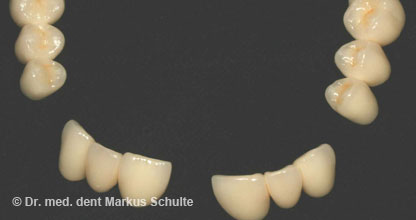
After six months the implants had become fully integrated into the bone so that we were able to install the definitive replacements. After taking an impression, individual ceramic posts (abutments) made in the dental laboratory were screwed onto the implants in the upper jaw. We then cemented the four separate metal-free all ceramic bridges onto these ceramic abutments.
